





Paksil
Application instruction:
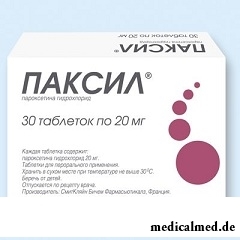 Paksil – drug with antidepressive action.
Paksil – drug with antidepressive action.
Form of release and structure
Dosage form of release of Paksil – a tablet, film coated: white, biconvex, oval; on one party – risk, on another – an engraving "20" (on 10 pieces in blisters, on 1, 3 or 10 blisters in a cardboard pack).
Structure of 1 tablet:
- Active ingredient: пароксетин – 20 mg (a paroksetina of a hydrochloride гемигидрат – 22,8 mg);
- Additional components and cover: Opadry white – 7 mg (a macrogoal of 400 - 0,6 mg, a gipromelloza – 4,2 mg, titanium dioxide – 2,2 mg, polysorbate of 80 - 0,1 mg), magnesium stearate – 3,5 mg, a calcium hydrophosphate dihydrate – 317,75 mg, sodium carboxymethylstarch (type A) – 5,95 mg.
Indications to use
- Depression of all types, including heavy and situational depression, and also the depression proceeding with alarm. By efficiency effect of drug has similarity to tricyclic antidepressants. There are data that it yields good results at patients at inefficiency of standard treatment with antidepressants. At long therapy Paksil is effective for prevention of a recurrence of a depression;
- Panic frustration with an agoraphobia and without it – as means of the supporting and preventive therapy; drug is most effective at use in a combination with cognitive and behavioural treatment;
- The Obsessivno-kompulsivnye Frustration (OKF) – as the supporting and preventive therapy; drug is effective at use with the preventive purpose for prevention of a recurrence;
- Social phobia – as the supporting and preventive therapy;
- Generalized alarming frustration – as the long supporting and preventive therapy; drug is effective for prevention of a recurrence;
- Posttraumatic stressful frustration – treatment.
Contraindications
- The combined use with methylene blue, Pimozidum, thioridazine and monoamine oxidase inhibitors (with the last it is necessary to observe an interval not less than 14 days);
- Age up to 18 years;
- Hypersensitivity to drug components.
In case of need Paksil's uses by pregnant women to women, and also when planning pregnancy it is recommended to consider the possibility of purpose of alternative treatment.
Route of administration and dosage
Pill Paksil should be taken inside, without chewing, entirely, it is desirable – in the morning along with meal.
It is recommended to observe the following mode of dosing (a daily dose with frequency rate of reception once a day):
- Depression: 20 mg (initial dose). In case of need perhaps step-by-step increase in a dose (on 10 mg of 1 times in 7 days) before achievement of maximum – 50 mg. It is necessary to estimate Paksil's efficiency for the purpose of dose adjustment in 2-3 weeks of therapy. Duration of a course is defined by indications (up to several months);
- Panic frustration: 10 mg (initial dose). In case of need perhaps step-by-step increase in a dose (on 10 mg of 1 times in 7 days) to recommended or maximum (40/60 mg). Course duration – several months and longer;
- ROC: 20 mg (initial dose). In case of need perhaps step-by-step increase in a dose (on 10 mg of 1 times in 7 days) to recommended or maximum (40/60 mg). Course duration – several months and longer;
- Social phobia, generalized alarming and posttraumatic stressful frustration: 20 mg (initial dose). In case of need perhaps step-by-step increase in a dose (on 10 mg of 1 times in 7 days) to 50 mg.
After the end of therapy to reduce probability of emergence of a withdrawal, it is necessary to reduce a drug dose before achievement of 20 mg step by step – on 10 mg a week. In 7 days Paksil it is possible to cancel completely. If symptoms of cancellation are observed at decrease in a dose or after drug withdrawal, it is reasonable to resume therapy in the dose appointed earlier, and then to reduce a dose more slowly.
Patients at advanced age need to begin therapy with the recommended initial dose which it is possible to increase gradually to 40 mg a day. Patients with heavy functional disturbances of kidneys (the clearance of creatinine – is less than 30 ml in a minute) should appoint reduced doses (in the lower part of therapeutic range).
Side effects
Frequency and intensity of some listed below disturbances connected with Paksil's reception in process of continuation of therapy can decrease. In this case usually drug withdrawal is not required.
During treatment there can be following side effects (> 1/10 – very often;> 1/100, <1/10 – it is frequent;> 1/1000, <1/100 – infrequently;> 1/10 000, <1/1000 – it is rare; <1/10 000, taking into account separate cases – it is very rare):
- Respiratory system: often – yawning;
- Nervous system: often – dizziness, a tremor, a headache; infrequently – extrapyramidal frustration; seldom – an akathisia, spasms, a syndrome of uneasy legs; very seldom – a serotoninovy syndrome (in the form of hallucinations, agitation, confusion of consciousness, the strengthened sweating, a hyperreflexia, a myoclonus, tachycardia with a shiver and a tremor); in rare instances at simultaneous use with neuroleptics or disturbance of motive functions – extrapyramidal symptomatology, including orofatsialny dystonia;
- Cardiovascular system: infrequently – postural hypotonia, sinus tachycardia;
- Gepatobiliarny system: seldom – increase in level of liver enzymes; very seldom – a liver failure and/or the hepatitis which is followed in certain cases by jaundice; sometimes – increase in levels of liver enzymes; seldom or never (on the basis of results of post-marketing observations) – damages of a liver (in the form of a liver failure and/or hepatitis, sometimes with jaundice);
- Hemopoietic system: infrequently – abnormal bleedings, mainly, in mucous membranes and skin (in most cases – bruises); very seldom – thrombocytopenia;
- Digestive tract: very often – nausea; often – dryness in a mouth, vomiting, diarrhea, a lock; very seldom – gastrointestinal bleedings;
- Immune system: very seldom – allergic reactions (including a Quincke's disease, a small tortoiseshell);
- Mentality: often – agitation, sleeplessness, drowsiness, unusual dreams (including dreadful dreams); infrequently – hallucinations, confusion of consciousness; seldom – maniacal reactions (also these disturbances can be connected with a disease);
- Urinary system: seldom – an urination delay, an urine incontience;
- Endocrine system: very seldom – a syndrome of disturbance of secretion of antidiuretic hormone;
- Food and metabolism: often – appetite reduction, increase in level of cholesterol; seldom – a hyponatremia (in most cases – at elderly patients);
- Sight: often – a sight illegibility; infrequently – a mydriasis; very seldom – acute glaucoma;
- Reproductive system and mammary glands: very often – sexual dysfunction; seldom – гиперпролактинемия / a galactorrhoea;
- Hypodermic fabrics and skin: often – perspiration; infrequently – skin rashes; very seldom – heavy skin reactions, photosensitivity reactions;
- Others: often – increase in weight, an adynamy; very seldom – peripheral hypostases.
At cancellation of reception of Paksil such disturbances can develop:
- Often: sleep disorders, alarm, touch disturbances, headache, dizziness;
- Infrequently: confusion of consciousness, diarrhea, nausea, perspiration, agitation, tremor.
Paksil's reception at children can lead to emergence of the following side effects: emotional lability (including suicide attempts and thoughts, mood swings, infliction of harm to, tearfulness), perspiration, hyperkinesia, appetite reduction, hostility, agitation, tremor.
Special instructions
At patients at young age, especially during treatment of big depressive frustration, Paksil's reception can increase risk of development of suicide behavior.
The aggravation of symptoms at a depression and/or emergence of suicide thoughts and suicide behavior can occur irrespective of whether the patient receives antidepressants. The probability of their development remains until approach of the expressed remission. Because improvement of a condition of patients, as a rule, occurs in several weeks of reception of Paksil, during this period they need to provide careful control of a state, especially at the beginning of a medical course.
It is necessary to consider that at other mental disorders at which Paksil is shown there is a high risk of suicide behavior too.
In some cases, most often in the first several weeks of therapy, use of drug can lead to developing of an akathisia (it is shown in the form of internal concern and psychomotor excitement when the patient cannot be in a quiet state – to sit or stand).
Such disturbances as agitation, akathisia or mania, can be displays of the main disease or develop as side effect of reception of Paksil. Therefore in cases when the available symptoms worsen, or at development of new, it is necessary to address the specialist for consultation.
Sometimes, most often during the combined use with other serotonergic drugs and/or neuroleptics, development of a serotoninovy syndrome or symptoms which are similar to a malignant antipsychotic syndrome is possible. If there are such symptoms as the vegetative frustration, a myoclonus, a hyperthermia, muscular rigidities which are followed at the same time by fast changings of indicators of functions, important for life, and also the changes of the mental status including confusion of consciousness and irritability cancel treatment.
Big depressive episodes in certain cases are initial display of bipolar disorders. It is considered that monotherapy by Paksil can increase probability of the accelerated development of the maniacal / mixed episode in the patients subject to risk of emergence of this state. Before purpose of drug for assessment of risk of development of bipolar disorder it is necessary to carry out the careful screening including the detailed psychiatric family anamnesis with data on cases of a depression, a suicide and bipolar disorder. Within bipolar disorder Paksil is not intended for therapy of a depressive episode. With care patients should appoint it with the anamnestic data indicating existence of a mania. Also purpose of drug demands care against the background of epilepsy, the closed-angle glaucoma contributing to bleedings of diseases including use of the substances/medicines increasing probability of development of bleedings.
Development of symptoms of cancellation (in the form of suicide thoughts and attempts, changeability of mood, nausea, tearfulness, nervousness, dizziness, pains in a stomach) does not mean that Paksil causes dependence or the fact that abuse it.
If during treatment convulsive attacks develop, Paksil cancel.
Because of the existing risk of development of side effects from mentality and a nervous system, in operating time with mechanisms and at control of motor transport it is necessary to be sick especially careful.
Medicinal interaction
Absorption (absorption) and Paksil's pharmacokinetics at alcohol intake, food, digoxin, antacids, propranolol does not change, however it is not recommended to take the drinks containing alcohol during therapy.
At the combined use of Paksil with some substances / medicines development of the following effects is possible:
- Pimozidum: its level in blood increases, QT interval is extended (such combination of drugs is contraindicated; in need of the combined use it is necessary to be careful and carry out careful monitoring of a state);
- Serotonergic medicines (including lithium, triptanes, fentanyl, L-tryptophane, SIOZS group drugs, трамадол and vegetable means with the maintenance of the made a hole St. John's Wort): the probability of development of a serotoninovy syndrome increases (the combined use of Paksil with monoamine oxidase inhibitors and linezolidy is contraindicated);
- Ritonavir and/or фосампренавир: considerably Paksil's concentration in a blood plasma decreases;
- Inhibitors and enzymes which take part in metabolism of medicines: the pharmacokinetics and metabolism of a paroksetin changes;
- Drugs which are metabolized by CYP2D6 liver enzyme (tricyclic antidepressants, thioridazine, Perfenazinum and other antipsychotic drugs of a fenotiazinovy row, атомоксетин, рисперидон, флекаинид, пропафенон and some other antiarrhytmic means of a class 1 C): their concentration in plasma increases;
- Protsiklidin: its concentration in a blood plasma (at development of anticholinergic effects its dose needs to be reduced) increases.
Terms and storage conditions
To store in the place, unavailable to children, at a temperature up to 30 °C.
Period of validity – 3 years.
Name of drug
Price
Drugstore
Paksil тбл п / about 20 mg No. 30 *, Es. SI. Evrofarm of Es. And.
714 rub.
 Network of the Moscow drugstores of IFC
Network of the Moscow drugstores of IFCPaksil тбл п / about 20 mg No. 100 *, Es. SI. Evrofarm of Es. And.
2205 rub.
 Network of the Moscow drugstores of IFC
Network of the Moscow drugstores of IFCThe weight of a human brain makes about 2% of all body weight, however it consumes about 20% of the oxygen coming to blood. This fact does a human brain extremely susceptible to the damages caused by shortage of oxygen.
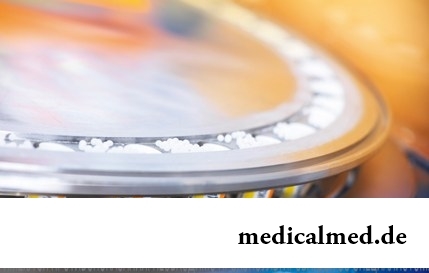
For the help to doctors in the choice of optimal solutions for treatment of various diseases the Cochrane scientific organization (Cochrane) will see off совм...
Section: Articles about health
The immunity role in growth of the child is invaluable. The proteins-immunoglobulins produced by immune system preserve the child against the diseases capable − owing to an organism weak still − to serve as a stressful factor, to become the reason of many complications and delays in unless...
Section: Articles about health
Life does not indulge the modern woman special emotional comfort and carelessness. The fatigue, troubles at work, misunderstanding in a family and various illnesses immediately affect a condition of hair and skin. And there is a wish to look safe and attractive so! Substantially competently picked up diet can improve situation....
Section: Articles about health
What is in our understanding weeds? It plants which are considered to be suitable only for compost pits and feeding жи...
Section: Articles about health
The phenomenon of the panic attack is known long ago, but the reasons of its emergence still are up to the end not found out. It is established that more than 30% of people at least once in life become the victims of very unpleasant phenomenon: without everyones on that the reasons they have a feeling of horror, with...
Section: Articles about health
80% of women at least once to lives complained of discomfortable feelings to breasts, consolidations and nagrubaniye. These are mastopathy symptoms. The mastopathy is characterized by change of a ratio between ferruterous and connective tissue tissues of mammary glands. It can lead to formation of cysts (a cystous mastopathy), gland consolidation (a fibrous mastopathy), or a combination of these processes (a fibrous and cystous mastopathy)....
Section: Articles about health
The unpleasant feelings connected with spring breakdown are familiar almost to each of us. Often happens that in March-April on the person...
Section: Articles about health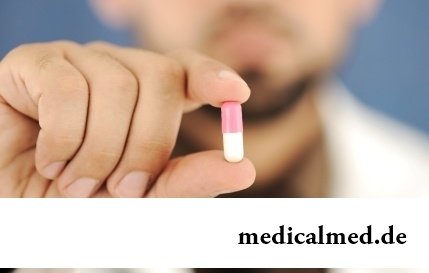
The drugs stopping or oppressing life activity of pathogenic microorganisms are widely applied in clinical practice from 40th years of the last century. Originally antibiotics were called only substances natural (animal, vegetable or микробног...
Section: Articles about health
Statistically, pathologies of a thyroid gland in the world more than 500 million people have. Failures in work of this body lead to heavy disbolism, development of heart diseases, vessels, a reproductive and nervous system. In hard cases excess or insufficient production of the main hormones of a thyroid gland (thyroxine and triiodothyronine) leads to essential decline in quality of life and disability....
Section: Articles about health
The next flu epidemic leads to the next panic, from year to year we give in on these manipulations: professionally alarming goal...
Section: Articles about health
Climax - process of fading of reproductive function of an organism in process of its aging. At women the main sign of its approach is the termination of a menstrual cycle. Officially the menopause is diagnosed when periods are not observed in течен...
Section: Articles about health
On health of the person physicians know about salutary action of animals long ago. About 7 thousand years ago great Hippocrates recommended to the patients riding walks for strengthening of a nervous system and increase in vitality....
Section: Articles about health
Condition of lips (their morbidity, outward) – one of indicators of health of the person. Peeling, dryness, pallor, and also трещ...
Section: Articles about health
Stroke (acute disorder of cerebral circulation) – one of the most widespread neurologic diseases. Annually in the world more than 6 million people die of this illness. From the survived patients about 80% become disabled people, and nearly a thirds from them впо...
Section: Articles about health
The problem of diagnosis was and remains to one of the most important in medicine. From that, the reason of an indisposition of the patient will be how precisely defined, eventually success of treatment depends. In spite of the fact that the majority of the diagnostic methods applied in official clinical practice has very high informational content and reliability, mistakes directed by diagnoses nevertheless are not excluded....
Section: Articles about health
The modern person not always manages to find housing in the environmentally friendly region and such work which would not do harm здо...
Section: Articles about health
The advantage of swimming for the person is so high that this sport is not only the most popular, but also is widely applied in medicine and rehabilitation processes. If you look for for yourself the occupation allowing pleasantly and to spend time, then swimming with advantage...
Section: Slideshow
About 10-15 years ago existence of the computer in the apartment of the Russian was considered as a rarity and office rooms were only at the first stage of equipment by these useful devices. Today practically in each house there is a computer (and often not one), and a regular user is already every our second compatriot. Convenience and efficiency of personal computers are undoubted, but the people working with them daily have to know also about health hazard which they can predstavlit...
Section: Articles about health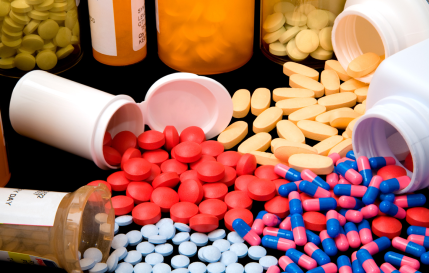
Long time antibiotics were considered as a panacea from all diseases and were appointed even at insignificant symptoms of an infection. Even now...
Section: Articles about health
Cold, puffiness of a nose, itch, the watering eyes - characteristic symptoms of the allergic rhinitis resulting from hit of allergens (pollen, house dust, hair of animals, etc.) on a mucous membrane of a nose. Unpleasant feelings often deliver беспоко...
Section: Articles about health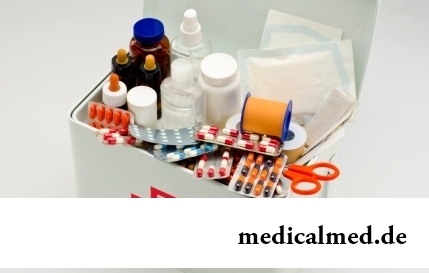
All know that self-treatment is dangerous. However absolutely it is almost impossible to do without it. Rate of modern life does not allow to handle each small trouble to the doctor and information on ways of independent delivery of health care is quite available. Means, all of us have only one: to learn to give this help competently and in those limits in which it is possible for the person who does not have vocational education....
Section: Articles about health
The fatigue, sleep debt, disturbances of food, bad mood, vagaries of the weather – all these circumstances badly are reflected in our vn...
Section: Articles about health
Physical activity is necessary for normal functioning of a human body. At a lack of the movement joints cease to function, muscles atrophy, cardiovascular activity is broken and the metabolism worsens. Modern городс...
Section: Articles about health
It seems, quite recently you brought the baby from maternity hospital, but time flew by, and here it is already going to join the first in life children's collective. How to prepare the child for visit of a garden? What needs to teach him to facilitate adaptation process? What to tell and how to behave that the kid transferred changes in the life without serious consequences? Let's try to find answers to these questions....
Section: Articles about health
The naturopathy sometimes moves as the new direction of medicine, something like fashionable hobby, and there is nothing farther from the truth....
Section: Articles about health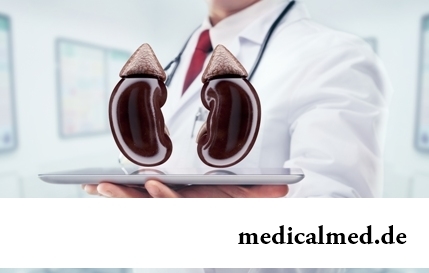
Kidneys perform the most important function of clarification of blood from those products of metabolic processes which cannot be used by an organism for obtaining energy and construction of new cells. With the urine produced by kidneys from a body of the person bulk is removed...
Section: Articles about health
Good appetite was always considered as a sign of good health. The correct operation of the mechanism which is responsible for the need for nutrients and receiving pleasure from process of its satisfaction demonstrates that the organism functions without special deviations. On the other hand, appetite of the person is not a constant. It depends on the culture of food, flavoring addictions imparted since the childhood which can change during life, weather, mood and many д more than once...
Section: Articles about health

